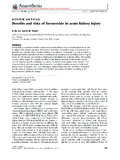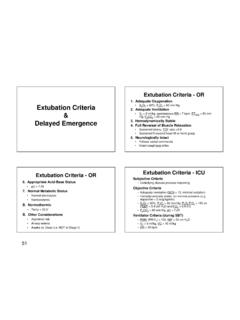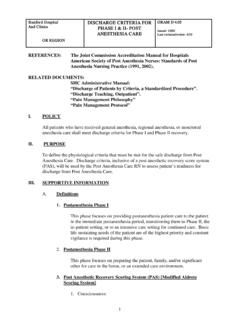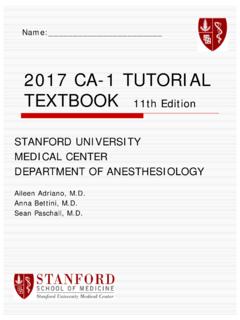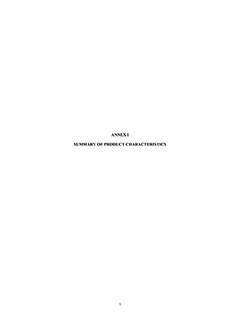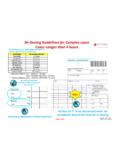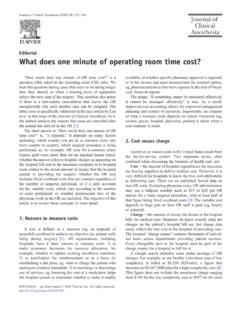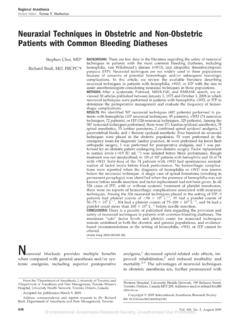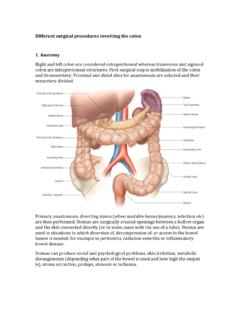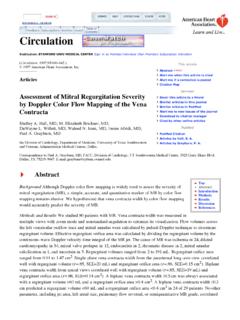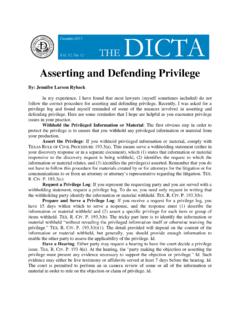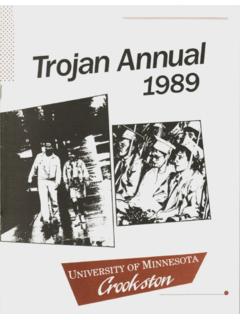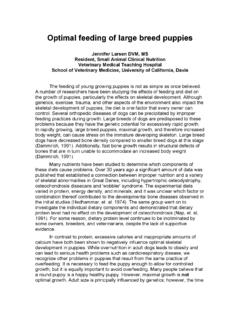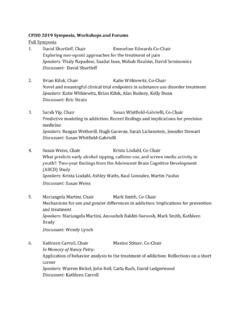Transcription of 2016 CA-1 TUTORIAL TEXTBOOK 10th Edition STANFORD ...
1 2016 CA-1 TUTORIAL TEXTBOOKSTANFORD university medical CENTERDEPARTMENT OF ANESTHESIOLOGYA ileen Adriano, Sacks, O Hear, EditionName:_____1 TABLE OF CONTENTS Key Points and Goals of the CA-1 TUTORIAL Checklist for CA-1 Mentorship Intraoperative CA-1 TUTORIAL Didactic CA-1 Mentorship Intraoperative Didactic Lectures Standard Inhalational MAC and IV Anesthetic Rational Opioid Intraoperative Hypotension & Neuromuscular Blocking Difficult Airway Fluid Management .. Transfusion Electrolyte Hypothermia & Extubation Criteria & Delayed Laryngospasm & Oxygen Failure in the Local Malignant Perioperative Topics for Fun 2 INTRODUCTION TO THE CA-1 TUTORIAL MONTH We want to welcome you as the newest members of the department of Anesthesia at STANFORD !
2 Your first weeks and months as an anesthesia resident are exciting, challenging, stressful, and rewarding. Regardless how much or how little experience you have in the field of anesthesiology, the learning curve for the next few months will be very steep. In addition to structured lectures and independent study, you will be primarily responsible for patients as they undergo anesthesia and surgery. Several years ago, before the development of this mentoring and TUTORIAL system, CA-1 s had little structure to their first month. While there were regular intra-operative and didactic lectures, the nuts and bolts of anesthesiology were taught with little continuity.
3 CA-1 s worked with different attendings every day and spent as much time adjusting to their particular styles as they did learning the basics of anesthesia practice. Starting in 2007, the first month of residency was overhauled to include mentors: each CA-1 at STANFORD was matched with an attending or senior resident for a week at a time. In addition, a TUTORIAL curriculum was refined to give structure to the intra-operative teaching and avoid redundancy in lectures. By all accounts, the system has been a great success! There is so much material to cover in your first couple months of residency that independent study is a must.
4 Teaching in the OR is lost without a foundation of knowledge. Afternoon lectures are more meaningful if you have already read or discussed the material. This booklet serves as a launching point for independent study. While you review the TUTORIAL with your mentor, use each lecture as a starting point for conversations or questions. During your mentorship, we hope you can use your mentor as a role model for interacting with patients, surgeons, consultants, nurses and other OR personnel. This month, you will interact with most surgical specialties as well as nurses in the OR, PACU, and ICU.
5 We suggest you introduce yourself to them and draw on their expertise as well. Nobody expects you to be an independent anesthesia resident after just one month of training. You will spend the next three years at STANFORD learning the finer points of anesthesia practice, subspecialty anesthesiology, ICU care, pre-operative and post-operative evaluation and management, etc. By the end of this month, we hope you attain a basic knowledge and skill-set that will allow you to understand your environment, know when to ask for help, and determine how to direct self-study.
6 Sprinkled throughout this book, you ll find some light-hearted resident anecdotes from all the good times you ll soon have, too. CA-1 Introduction to Anesthesia Lecture Series: The Introduction to Anesthesia Lecture series, given by attendings designed to introduce you to the basic concepts of anesthesia. Topics covered include basic pharmacology of anesthetics, basic physiology, and various clinical skills and topics. This lecture series starts on July 5th at 4pm in the Anesthesia Conference room. A schedule of lectures is included on pg 10.
7 The last lecture is July 28th. You will be relieved of all clinical duties to attend these lectures. The department has purchased Miller s Basics of Anesthesia for use as a reference for these lectures. 3 ACKNOWLEDGEMENTS Thanks to Janine Roberts and Kathrina De La Cruz for their hard work and assistance in constructing the CA-1 Mentorship TEXTBOOK . Thanks to Dr. Pearl for his support and assistance with this endeavor. His guidance is appreciated by all. If you ever feel like you re staying too late, know that Dr. Pearl is probably still working in his office when you leave the OR.
8 Thanks to Dr. Macario, our Residency Program Director, who will be one of the first attendings to know each of you by your first name. Special thanks to Dr. Ryan Green, Class of 2008, founder of the CA-1 mentorship program, and principal editor of the first Edition of the CA-1 Mentorship TEXTBOOK . Lastly, thanks to all of the resident and faculty mentors at STANFORD university medical center , Palo Alto VA, and Santa Clara Valley medical center for all of their time and effort spent teaching STANFORD anesthesia residents. As you start this July, don t be too hard on yourself if you miss an IV or an intubation.
9 If it were that easy, no one would need residency. Also, try to go with the flow if plans change on you suddenly. Flexibility is very important in this field. May your first month be a smooth transition to your anesthesia career. Welcome to STANFORD Anesthesia. We hope you love it as much as we do! Please do not hesitate to contact us with any questions or concerns. Aileen Adriano, MD Sandra Sacks, MD Kelly O Hear, MD CONTRIBUTORS 10th Edition (2016) Editors: Sandra Sacks, MD Kelly O Hear, MD Aileen Adriano, MD Section Editors: Francesca Betti, MD Sean Paschall, MD Tenille Bany, MD Emmett Culligan, MD Wendy Ma, MD Erin Connor, MD Andrew Guistini, MD David Creighton, MD Sara Smith, MD Noelle Fabian, MD Dan Moy, MD Jocelyn Wong, MD Resident Mentors.
10 Sophie Turkmani-Bazzi, MD Rett Quattlebaum, MD Cynthia Khoo, MD Anna Harter, MD Melissa Vogelsong, MD Sean Paschall, MD Sarah Stone, MD Amy Kloosterboer, MD Jason Reminick, MD Anna Bettini, MD David Creighton, MD Luke McCage, MD Patty Olsyznski, MD Faculty Mentors Timothy Angelotti, MD, PhD Martin Angst, MD Naola Austin, MD Jennifer Basarab-Tung, MD Marianne Chen, MD Pamela Flood, MD Natalya Hasan, MD Boris Heifets, MD Praveen Kalra, MD Steven Lipman, MD Javier Lorenzo, MD Amy Lu, MD Chris Painter, MD Jessica Patterson, MD Roya Saffary, MD Sunita Sastry, MD Amit Saxena, MD 4 Steven Shafer, MD Eric Sun, MD Pedro Tanaka, MD, PhD 9th Edition (2015) Editors: Lindsay Borg, MD Ann Ng, MD Aileen Adriano, MD Section Editors: Anuj Aggarwal, MD Shara Cohn, MD Erin Crawford, MD Amit Joseph, MD Tyler King, MD Luke McCage, MD Quynh Nguyen, MD Kelly O hear, MD Patty Olszynski, MD Jordan Ruby, MD Sandra Sacks, MD Clair Secomb, MD Lauren Steffel, MD Anna Swenson, MD Louise Wen, MD Mentor Coordinators: Lindsay Borg, MD Resident Mentors.
